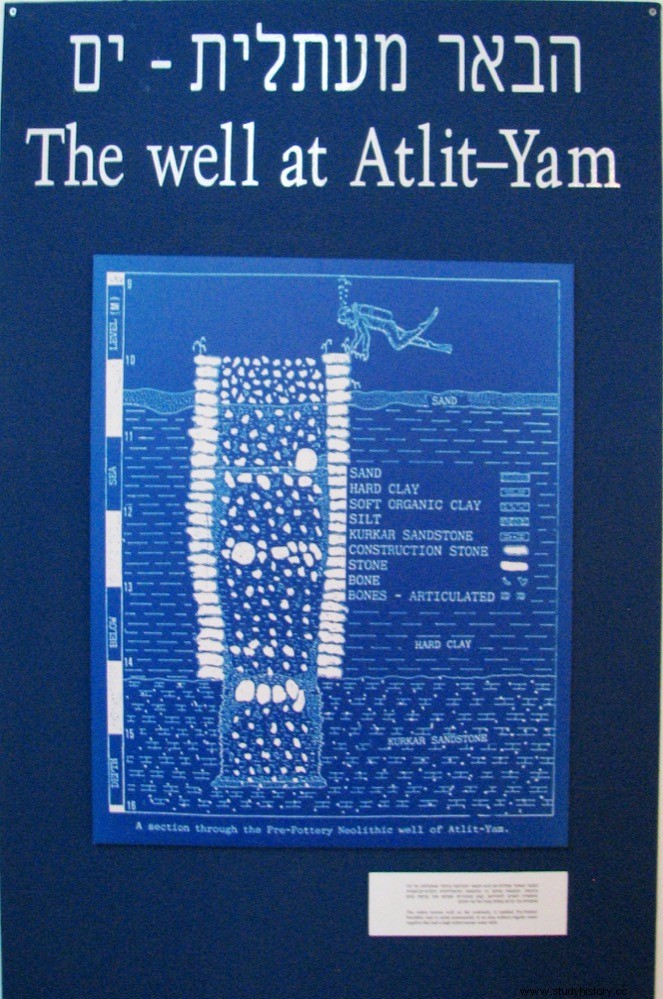8,000 years ago, an eruption of the Sicilian volcano Etna caused a gigantic collapse of its eastern slope. The landslide was so large, it is estimated at more than 24 million cubic meters, that when it hit the sea at more than 300 kilometers per hour it caused an enormous tsunami with waves up to 40 meters high that, in a short time, reached the coasts of the entire Mediterranean.
Within 15 minutes the whole of southern Italy was flooded. In an hour the western Greek coast, and half an hour later the Libyan and Egyptian coasts.
Three and a half hours after the start of the event, the waves reached the coasts of present-day Israel, Lebanon and Syria, at a speed of more than 350 kilometers per hour.

A study published in 2007 by Maria Pareschi and other researchers from the National Institute of Geophysics and Volcanology of Italy attributes the destruction of the Neolithic settlement of Atlit-Yam to this event, based on the fact that a well in the village was found filled with marine sediments dragged by the tsunami wave.
Atlit-Yam was discovered by underwater archaeologist Ehud Galili in 1984, submerged about 12 meters deep and half a kilometer off the coast of Carmel in Israel, at the mouth of the Oren River.

It was a town of about 60,000 square meters, which researchers date to around 8100–7500 BC, making it the oldest submerged human settlement discovered so far, more than 9,000 years old.
It is called village or village instead of city because no remains of organized streets have been found, but its size would well deserve that description. In fact the houses were large and made of stone, with paved floors, patios, fireplaces and water wells. The wealth of finds of material culture and organic remains are characteristic of a Neolithic pre-pottery people based on a mixed economy of agriculture and fishing from 9000 years ago.
The well in question referred to in Maria Pareschi's study was found by Galili in 1993. It is 1.5 meters in diameter and 5.7 deep, which means that the top of the well would have been about 5 meters above the sea level and that the level of the Mediterranean in the area 8,000 years ago, just before the tsunami, was 16 meters below the current level. The coastline was at that time 1 kilometer west of where it is today.
The site was abandoned in the face of rising sea levels and the settlement rebuilt further inland (today it is also submerged, closer to the shore). However, Pareschi's theory of sudden abandonment before the arrival of the tsunami gained strength with the discovery of piles of fish, which were being prepared for trade or storage, and which appear to have been hastily left in the face of imminent danger. 
Another of the most interesting finds is a semicircle of stones, formed by seven megaliths that weigh about 600 kilograms each. They are arranged around what was a freshwater spring, so archaeologists think it may have been used to perform some kind of ritual related to water.

Burials and human remains were found, some with damaged ears, which would indicate that they were diving for shellfish (the damage would be due to pressure and diving in cold water). Other finds include anthropomorphic stone steles, remains of wild plants and animals, arrowheads, blades and flint axes.
The importance of Atlit-Yam is that it offers us a glimpse of life in the Neolithic at a time when humans were changing from being hunter-gatherers to cultivating plants and raising livestock, perhaps the greatest revolution in our history. Moreover, it would be one of the first communities in which there is evidence of maritime activity and use of sea resources. Atlit-Yam is today one of the best preserved and most researched prehistoric sites in the world.
